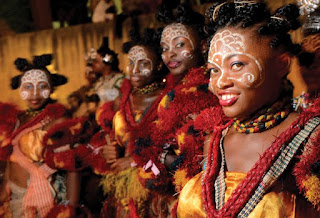Lesotho culture people food and festivals
People & Culture
According to the Lesotho Bureau of Statistics, preliminary results of the population census conducted in April 2006 put the country´s total population at 1872 721, with some 23.74 % of Lesotho inhabitants now living in the urban areas. Basotho speak the national language, Sesotho, and a vast majority speak excellent English which is a second language widely used in government and commerce as well as in schools. The next most commonly spoken language in Lesotho is Zulu, which is spoken by approximately a quarter of a million people in the Botha-Bothe district and in the vicinity of the Caledonspoort border post. Phuthi and Xhosa are also spoken. Although many Basotho still live and work outside the country, their attachment to their local village and traditional culture is still strong. The family is still the dominant unit, and respect for the elder generation is important. Basotho culture is centred on village life, and most traditions and festivals relate to local village life and the seasons of the year. Of all our people it is the Matabele who have preserved their traditions best, and their traditional dance Ndlamo is now a great way to celebrate throughout much of Lesotho, No traditional wedding is complete without this colourful dance. Basotho people are predominately rural, and getting around mountainous areas has always been difficult. However, the Basotho pony is ideal for local transportation and so breeding and riding these surefooted ponies is very important.
Arts and Crafts of the Basotho
Basotho people are renowned for their crafts. Traditional products have a reputation for quality, individuality and variety. They have a universal appeal, and have helped to give Lesotho a strong identity. They all make wonderful souvenirs of a visit to Lesotho. Lesotho has a justifiable reputation for its fine wool and mohair weaving. Tapestries, which are completely hand-woven, are works of art that display their own unique character, and are noted for their beauty, softness and strength. The artistic talent of many Basotho women also finds expression in the fine knitwear including pullovers, scarves and other personal items. The herds of sheep and goats that roam the hillsides provide the skins and hides for an abundant supply of sheepskin products
Food and Economy
Food in Daily Life. A three-stone fireplace in the courtyard is the focal point of the Basotho women's daily activity. Here they prepare the pot of cornmeal porridge (pap-pap ) which is the staple of the Basotho. Usually a sauce of peas, chopped greens, or other vegetables accompanies the thick porridge, and on special occasions a chicken is added to the pot. During the summer season, local peaches, and small, hard fruits add variety to the diet. In the winter, family members sit around the three-stone fireplace and roast ears of dried corn.
A local beer ( joale ) is brewed in a large vat placed on the three-stone fireplace. This beer is the center of informal neighborhood gatherings and provides a small income for the family. Milk is often served as a soured drink.
Maseru has a number of modern restaurants that are mostly patronized by business and professional people and tourists
Marriage, Family, and Kinship
Marriage. Lesotho is a blend of past and present, traditional and modern beliefs and practices. While church ceremonies are customary for weddings, the practice of extracting brideswealth from the man's family continues, making a family of daughters a lucrative situation. In turn, the bride becomes the property of the man, and leaves her family to live with the family of her husband.
Domestic Unit. The domestic unit consists of any number of the extended family. Often second or third cousins become "brothers" or "sisters." Grandmothers become official mothers. By tribal custom, widows become a wife of the brother or other male member of her deceased husband's family.
Kin Groups. The clans of the Sotho are often named for animals such as crocodiles and bears. The line of descendants is through the male, and members of the same clan are allowed to marry relatives as close as cousins.
Religion
Religious Beliefs. Religion in Lesotho is a mix of traditionally based ancestor worship and Christianity (about 80 percent), with a small representation of Islam. The main church groups are Catholic, Anglican, and Dutch Reformed. The dominance of the Catholic religion reflects the church's involvement in education, with over 75 percent of all primary and secondary schools being owned and managed by Catholics. Many church services include traditional Lesotho rituals such as chanting, drumming, and cultural costumes

























































